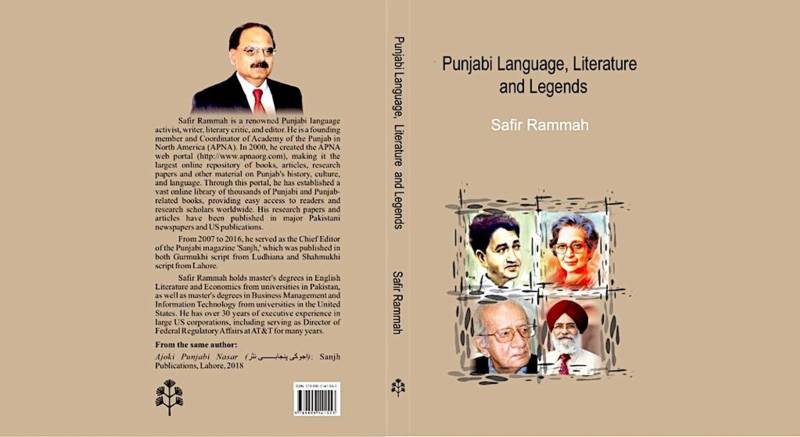
مینوں کئیاں نیں آکھیا کئی واری
توں لیناں پنجابی دا ناں چھڈ دے
مینوں انج لگدا لوکی آکھدے نیں
او پُتر !اپنی توں ماں چھڈ دے
اُستاد دامن
The volume in my hand, Punjabi Language, Literature and Legends, is the work of Safir Rammah, a distinguished figure in the realm of Punjabi language activism, literary criticism, and editorial work. Published by Kitab Trinjan, the only publishing house that is working for the promotion of Punjabi Language and literature, Rammah’s name is synonymous with dedication to the Punjabi language. A founding member and coordinator of the Academy of the Punjab of North America (APNA), Rammah has made indelible contributions to the preservation and promotion of Punjab’s rich cultural and linguistic heritage. In the year 2000, he launched the APNA web portal, which quickly became the largest online repository dedicated to the history, culture and language of Punjab. Through this platform, he has curated an immense digital library, housing thousands of books, research papers, articles, and other materials, providing easy access to readers and scholars worldwide. Rammah’s scholarly works have graced the pages of prominent Pakistani and American publications, while his stewardship as Chief Editor of the Sanjh magazine, published in both Gurmukhi and Shahmukhi scripts from Ludhiana and Lahore respectively, further cemented his legacy in Punjabi literature. With over 5,000 books to his name, Rammah has devoted his life to the advancement of his mother tongue, championing its development and widespread dissemination for the benefit of future generations.
Title: Punjabi Language, Literature and Legends
Author: Safir Rammah
Pages: 198
Price: PKR 1,000
Publishers: Kitab Trinjan, Temple Road, Lahore
The book is structured in four distinct sections, with the first “On Punjabi Literature and Writers” focusing on Punjabi literature and its celebrated writers. Within this section, the longest and most poignant essay is dedicated to the legendary Shiv Kumar Batalvi (1936–1973), the eminent Punjabi lyrical poet, exploring both his life and his poetry. Rammah offers a comprehensive biographical account and a profound analysis of Batalvi’s work, delving deeply into its nuances. It is evident that Rammah shares a deep admiration for Shiv’s poetic genius. Through his writing, Rammah gradually unveils the harsh truths of life, layer by layer. While these realities were never truly concealed from his readers, I find great value in the author’s meticulous examination of the poet’s life. This essay stands as an authoritative piece on Shiv’s existence, one that could be cited as a definitive reference on the subject. Rammah’s analysis takes on an almost anthropological scope, chronicling Shiv’s journey from childhood to his untimely death. It is, in essence, a tragic obituary for a life cut short, yet immortalised through poetry.
اساں تاں جوبن رُتے مرنا
Rammah eloquently asserts that Shiv was far more than a poet of a handful of celebrated verses or a limited array of themes. He vehemently denounces the critics who have carelessly affixed reductive labels to Shiv, portraying him as merely a poet of birha (separation) or likening him to a reincarnation of Keats. Such characterisations, Rammah argues, fail to grasp the depth and breadth of Shiv's poetic genius, which transcends these narrow confines. Shiv's work, though often subjected to severe criticism and outright condemnation, has been unjustly accused of lacking social awareness and being overly romantic. As Pash (1993) poignantly observes, “The pain in Shiv’s poetry is misinterpreted as irrational and unscientific. In truth, it is the raw, emotional response of a sensitive soul to the unempirical and alienating social and material relationships in society.”
Rammah also delves into Shiv’s enduring popularity, declaring him the most illustrious Punjabi poet of his time. He highlights how Shiv’s fame has only grown since his untimely demise, surpassing that of all his modern contemporaries. Critics have often debated whether Shiv’s poetry belongs to the classical or the traditional genre. In response, Rammah deftly demonstrates that, at a time when many of Shiv’s peers were turning to the progressive literary trends of the modern West, Shiv drew his inspiration from the classical literary heritage of his own land. Rammah underscores the essence of Shiv’s poetry, crafted in a simple, lyrical language designed to resonate with the common folk and to be sung rather than merely read. He vividly portrays how Shiv’s verses capture the vibrant tapestry of Punjab’s cultural life—the sights, sounds, symbols, and essence of rural existence—which, unlike the works of Waris Shah, had not been formally chronicled before. These elements, Rammah argues, root Shiv’s poetry firmly in the classical and traditional canon. He reinforces this claim by referencing examples from Shiv’s widely beloved poems.
Safir Rammah champions the art, culture, writers, and writings rooted in the land of Punjab, highlighting the challenges they have faced since 1947
Some critics have observed that certain prominent Punjabi poets and writers, such as Ustaad Daman and Shafqat Tanveer Mirza, receive comparatively less attention than Shiv, despite their significant contributions to Punjabi literature and deserving greater recognition. Furthermore, the absence of several other writers and scholars who have enriched the Punjabi language and its literary tradition is also notable. Nonetheless, Rammah’s effort in presenting a comprehensive and insightful biographical account of Shiv’s life and poetry is commendable. It is important to acknowledge that a writer’s creative vision and narrative choices cannot be dictated or constrained by external expectations.
In the following section, “The poetic tradition of West Punjab”, spanning from Ustaad Daman to Najam Hussain Syed, is thoughtfully explored. The focus is placed on the evolution of Punjabi poetry in the region after the partition of 1947. The works of eminent poets such as Ustaad Daman, Shareef Kunjahi, Ahmad Rahi, Muneer Niazi, and Najam Hussain Syed are critically examined, highlighting their contributions to the rich tapestry of Punjabi literature. Additionally, I came across an intricately crafted article on Baba Bulleh Shah, presented as a guiding luminary of Punjab’s poetic heritage. This piece is both historically grounded and profoundly insightful, offering an eloquent articulation of Baba Jee’s verses and their enduring significance.
The second part of the book “On Punjabi Language” delves into the Punjabi language, where Rammah presents a meticulously researched and richly informative article titled “Status of Punjabi in Pakistan.” Through this contribution, he offers readers a compelling analysis, supported by facts and figures, exploring the complex attitudes of Punjabis toward their own culture—marked by contempt and shame—and the underlying reasons for such behaviour. He critically examines what Punjab is capable of achieving to preserve its linguistic and cultural heritage and what it has historically failed to do, shedding light on both the causes and the far-reaching consequences of this neglect.
The third part of the book “In memory of some Punjabi Legends” pays homage to several iconic figures of Punjabi literature. Among its rich offerings, I discovered a comprehensive and insightful article on Surjeet Patar, a lyrical intellectual and one of the most distinguished Punjabi poets of our time. The section also honors Nadir Ali, a multifaceted short story writer, poet, and tireless advocate for Punjabi language rights. Additionally, it celebrates the legacy of Sharif Kunjahi, a poet, writer, teacher, and scholar who dedicated his life to the service of the Punjabi language with unwavering commitment. Finally, Amrita Pritam, described as a restless cloud—a poetess, novelist, and short story writer whose literary brilliance made her a towering figure in the literary landscape of South Asia.
The author illuminates the lives and creative artistry of these literary legends, shedding light on their significance and remarkable achievements. His dedication to preserving and promoting the language, culture, and literary heritage of Punjab is truly commendable. Through his unwavering efforts, he champions the art, culture, writers, and writings rooted in the land of Punjab, highlighting the challenges they have faced since 1947.
In the final section of the book, the author presents “Annual reports on Punjabi books and magazines spanning the years 2002 to 2005.” These meticulously crafted articles offer a year-by-year exploration of Punjabi literature, providing readers with a rich and informative study. To encapsulate the entirety of this book’s depth in a single article is an arduous task; the breadth of the author’s work can only be fully appreciated through a detailed and thoughtful reading of the book itself.
The highest praise is due to the author for crafting such an enlightening and comprehensive work, skilfully compiling his articles originally published in newspapers and magazines. This book stands as an essential read for enthusiasts and scholars of the Punjabi language and literature, offering a treasure trove of knowledge and insight.

